目录
[一. 概念](#一. 概念)
[二. 基类和派生类对象赋值转换](#二. 基类和派生类对象赋值转换)
[三. 继承中的作用域](#三. 继承中的作用域)
[四. 派生类的默认成员函数](#四. 派生类的默认成员函数)
[1. 构造函数](#1. 构造函数)
[2. 拷贝构造](#2. 拷贝构造)
[3. 赋值重载](#3. 赋值重载)
[4. 析构函数](#4. 析构函数)
[五. 继承与友元](#五. 继承与友元)
[六. 继承与静态成员](#六. 继承与静态成员)
[七. 多继承、菱形继承、菱形虚拟继承](#七. 多继承、菱形继承、菱形虚拟继承)
[八. 继承和组合](#八. 继承和组合)
一. 概念
继承是类设计层次的复用
**语法:**Person是父类,也称作基类。Student是子类,也称作派生类
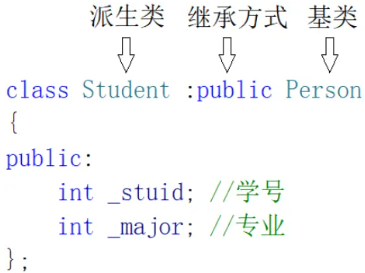
继承关系和访问限定符:

继承以后,保护和私有不一样了
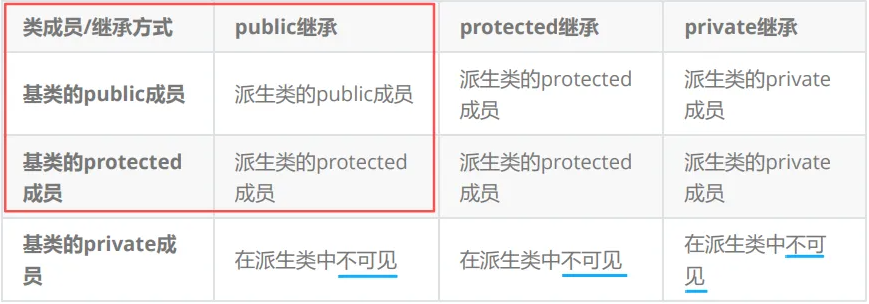
- 不可见:基类的私有成员还是被继承到了派生类对象中,但是语法上限制派生类对象不管在类里面还是类外面,都不能去访问它。基类的私有成员在基类中还是能用,在基类外不能用
- 如果基类成员不想在类外直接被访问,但需要在 派生类中能访问,就把基类成员定义为protected
- 基类的私有成员在子类都是不可见。基类的其他成员在子类的访问方式 == Min(成员在基类的访问限定符,继承方式),public > protected > private
二. 基类和派生类对象赋值转换
不同类型对象赋值要类型转换
cpp
int i = 0;
double d = i;
cpp
class Person
{
public:
void Print()
{
cout << "name:" << _name << endl;
cout << "age:" << _age << endl;
}
protected:
string _name = "peter"; // 姓名
int _age = 18; // 年龄
};
class Student : public Person
{
protected:
int _stuid; // 学号
};
class Teacher : public Person
{
protected:
int _jobid; // 工号
};父类对象不能赋值给子类对象,强转也不行 :否则子类特有的成员变量怎么办,给随机值?
父类对象可以赋值给子类的指针、引用(后面说)
cpp
int main()
{
Person p;
Student s;
// s = p; 错:父类不能赋值给子类
// s = (Student)p; 强转也不行
p = s;
Person p1 = s;
return 0;
}子类对象可以赋值给父类的对象、指针、引用
子类赋值给父类对象 ,语法上特殊处理,没有发生类型转换,而是 赋值兼容(切割、切片)
把子类里,父类那部分切出来,拷贝给父类
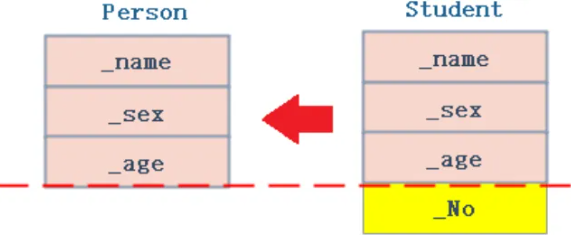
怎么证明没有发生类型转换?用另一种语法
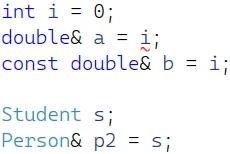
p2 变成子类中,父类那一部分的别名
把父类的成员变量放成 public
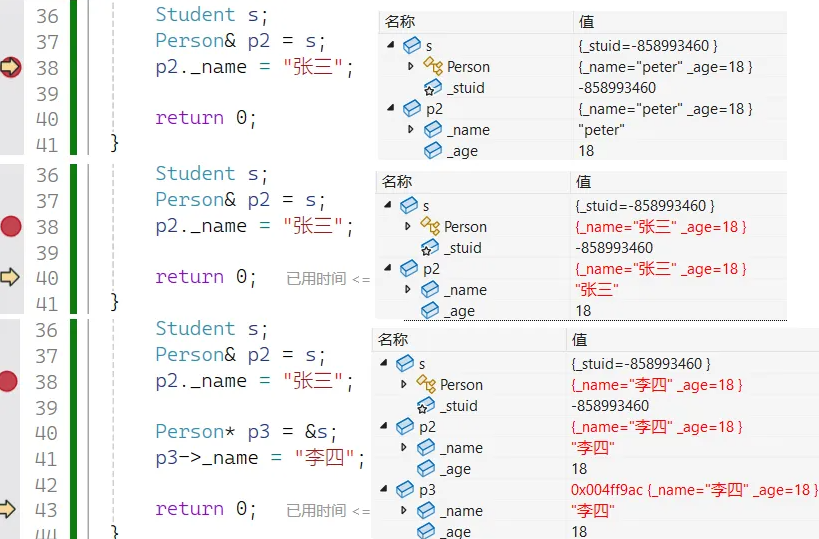
三. 继承中的作用域
域都是编译时,查找规则的概念
定义了一个类,就有类域。子类和父类有独立的类域
子 类和父 类中有同名成员 ,子类成员将屏蔽父类对同名成员的直接访问,这种情况叫隐藏 , 也叫重定义 。(在子类成员函数中,可以使用父类::父类成员显示访问)
父子类域中,如果是成员函数的隐藏 ,只需要函数名相同 就构成隐藏
现实中尽量不要在继承体系里定义同名成员
cpp
class Person
{
public:
void fun()
{
cout << "Person::func()" << endl;
}
protected:
string _name = "小李子"; // 姓名
int _num = 111; // 身份证号
};
// 隐藏/重定义:子类和父类有同名成员,子类的成员隐藏了父类的成员
class Student : public Person
{
public:
void fun(int)
{
cout << "Student::func(int)" << endl;
}
void Print()
{
cout << "姓名:" << _name << endl;
cout << _num << endl; // 999
cout << Person::_num << endl; // 111
}
protected:
int _num = 999; // 学号
};
int main()
{
Student s;
s.Print();
s.fun(1);
//s.fun(); 报错
//编译语法检查时,现在子类找func,找到了,要传参数,但你没传
s.Person::fun();
return 0;
}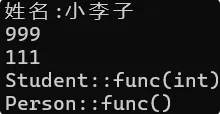
2个 func 构成什么关系?(a)
a、隐藏/重定义 b、重载 c、重写/覆盖 d、编译报错
同一作用域才能构成重载
四. 派生类的默认成员函数
设计理念:父干父的活,子干子的活
1. 构造函数
按以前的理解,子类有2个成员:_name 和 _id
规定:子类的构造函数中,不能在初始化列表显示初始化父类成员。在构造函数体内可以
cpp
class Person
{
public:
Person(const char* name = "peter")
: _name(name)
{
cout << "Person()" << endl;
}
~Person() { cout << "~Person()" << endl; }
protected:
string _name; // 姓名
};
class Student : public Person
{
public:
Student(const char* name = "张三", int id = 0)
:_id(0)
//,_name(name) 报错: "Student": 非法的成员初始化:"_name"不是基或成员
{ }
protected:
int _id;
};
int main()
{
Student s;
return 0;
}
没定义父类对象,但调用了父类的构造函数
规定: 子类必须调父类的构造函数**,初始化父类成员**
默认:在初始化列表自动调用父类的默认构造函数(父类不提供默认构造函数会报错)
若父类不提供默认构造函数:
cpp
class Person
{
public:
Person(const char* name)
: _name(name)
{
cout << "Person()" << endl;
}
~Person() { cout << "~Person()" << endl; }
protected:
string _name; // 姓名
};
class Student : public Person
{
public:
Student(const char* name = "张三", int id = 0)
:Person(name) // 比较特殊,类似于定义一个匿名对象
,_id(0)
{ }
protected:
int _id;
};
int main()
{
Student s;
return 0;
}不加19行会报错,19行的写法很特殊
调试发现,在初始化列表先走Person(name),说明:继承的成员声明在自己的成员之前
在初始化列表先写_id也可以,因为初始化顺序是按声明顺序来的
2. 拷贝构造
规定:必须调父类的拷贝构造
cpp
class Person
{
public:
Person(const char* name = "peter")
: _name(name)
{
cout << "Person()" << endl;
}
Person(const Person& p)
: _name(p._name)
{
cout << "Person(const Person& p)" << endl;
}
~Person() { cout << "~Person()" << endl; }
protected:
string _name; // 姓名
};
class Student : public Person
{
public:
Student(const char* name = "张三", int id = 0)
:Person(name)
,_id(0)
{ }
Student(const Student& s)
//:_name(s._name) 报错:: "Student": 非法的成员初始化:"_name"不是基或成员
:Person(s)
,_id(s._id)
{ }
protected:
int _id;
};
int main()
{
Student s1;
Student s2(s1);
return 0;
}
31行,父类拷贝构造要传父类对象,在这里只有子类对象,可以直接传:子类对象可以传给父类对象的指针/引用
如果删去31行,不会报错,但有问题:拷贝构造也是构造函数,构造函数在初始化列表不写,默认不会调拷贝构造函数,默认调默认构造函数

3. 赋值重载
cpp
class Person
{
public:
Person(const char* name = "peter")
: _name(name)
{
cout << "Person()" << endl;
}
Person(const Person& p)
: _name(p._name)
{
cout << "Person(const Person& p)" << endl;
}
Person& operator=(const Person& p)
{
cout << "Person operator=(const Person& p)" << endl;
if (this != &p)
_name = p._name;
return *this;
}
~Person() { cout << "~Person()" << endl; }
protected:
string _name; // 姓名
};
class Student : public Person
{
public:
Student(const char* name = "张三", int id = 0)
:Person(name)
,_id(0)
{ }
Student(const Student& s)
:Person(s)
,_id(s._id)
{ }
Student& operator=(const Student& s)
{
if (this != &s)
{
Person::operator=(s); // 构成隐藏,要显示访问
_id = s._id;
}
return *this;
}
protected:
int _id;
};
int main()
{
Student s1;
Student s3("李四", 1);
s1 = s3;
return 0;
}
4. 析构函数
cpp
class Person
{
public:
// ......
~Person()
{
cout << "~Person()" << endl;
}
protected:
string _name; // 姓名
};
class Student : public Person
{
public:
// ......
~Student()
{
//~Person(); 调不到
Person::~Person(); // 有问题
}
protected:
int _id;
};
int main()
{
Student s1;
Student s3("李四", 1);
s1 = s3;
return 0;
}为什么58行调不到,要指定父类类域?
由于后面多态的原因(具体后面讲),析构函数的函数名被特殊处理了,统一处理成destructor,此时构成隐藏
但此时又有新的问题,总共2个对象,调了4次析构函数
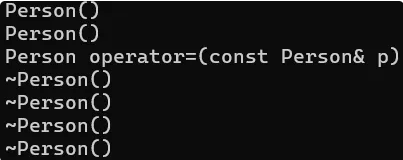
屏蔽59行反而正确了

构造、拷贝、赋值要显示调用
析构函数是个特殊,为保证析构顺序,会自动调
子类对象分开来看,分为父类部分和子类部分
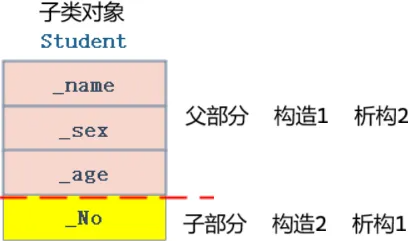
显示调用父类析构,无法保证先子后父的析构顺序
所以子类析构函数完成后,自动调用父类析构,这样就保证了先子后父的析构顺序
为什么要保证先子后父的析构顺序?
因为子类中有可能用到父类成员,父类不可能用到子类
eg:先析构父,子再访问父的成员
cpp
class Person
{
public:
Person(const char* name = "peter")
: _name(name)
{
cout << "Person()" << endl;
}
Person(const Person& p)
: _name(p._name)
{
cout << "Person(const Person& p)" << endl;
}
Person& operator=(const Person& p)
{
cout << "Person operator=(const Person& p)" << endl;
if (this != &p)
_name = p._name;
return *this;
}
~Person()
{
cout << "~Person()" << endl;
delete _pstr;
}
protected:
string _name; // 姓名
string* _pstr = new string("111111111");
};
class Student : public Person
{
public:
Student(const char* name = "张三", int id = 0)
:Person(name)
,_id(0)
{ }
Student(const Student& s)
:Person(s)
,_id(s._id)
{ }
Student& operator=(const Student& s)
{
if (this != &s)
{
Person::operator=(s);
_id = s._id;
}
return *this;
}
~Student()
{
//Person::~Person();
cout << *_pstr << endl; // 子类中有可能用到父类成员
}
protected:
int _id;
};
int main()
{
Student s1;
Student s3("李四", 1);
s1 = s3;
return 0;
}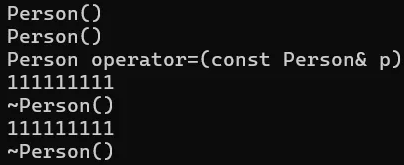
如果把 Person::~Person(); 放开:↓

五. 继承与友元
友元关系不能继承,父类友元不能访问子类私有和保护成员
cpp
class Student;
class Person
{
friend void Display(const Person& p, const Student& s);
protected:
string _name; // 姓名
};
class Student : public Person
{
friend void Display(const Person& p, const Student& s);
protected:
int _stuNum; // 学号
};
void Display(const Person& p, const Student& s)
{
cout << p._name << endl;
cout << s._stuNum << endl;
}
int main()
{
Person p;
Student s;
Display(p, s);
return 0;
}屏蔽掉11行会报错: "Student::_stuNum": 无法访问 protected 成员(在"Student"类中声明)
六. 继承与静态成员
以前的继承:子类对象中的父类成员,和父类对象成员不是同一个
父类定义了static静态成员,则整个继承体系里面只有一个这样的成员。无论派生出多少个子类,都只有一个static成员实例,在子类中不会单独拷贝一份
eg:↓ 统计Person及子类创建出多少个对象
cpp
class Person
{
public:
Person() { ++_count; }
//protected:
string _name; // 姓名
public:
static int _count; // 统计人的个数
};
int Person::_count = 0;
class Student : public Person
{
protected:
int _stuNum; // 学号
};
class Graduate : public Student
{
protected:
string _seminarCourse; // 研究科目
};
int main()
{
Person p;
Student s;
cout << &p._name << endl;
cout << &s._name << endl;
cout << &p._count<< endl;
cout << &s._count << endl;
cout << &Person::_count << endl;
cout << &Student::_count << endl;
return 0;
}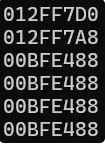
七. 多继承、菱形继承、菱形虚拟继承
实践中可以谨慎用多继承,不要用菱形继承
单继承:一个子类只有一个直接父类时称这个继承关系为单继承
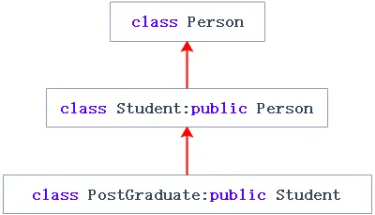
多继承:一个子类有两个或以上直接父类时称这个继承关系为多继承
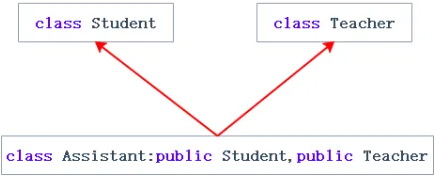
菱形继承:菱形继承是多继承的一种特殊情况
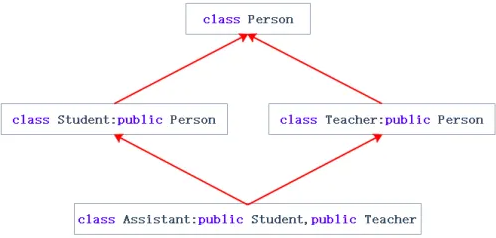
菱形继承的问题:数据冗余**(浪费空间)、** 二义性**(不知道要访问谁)**
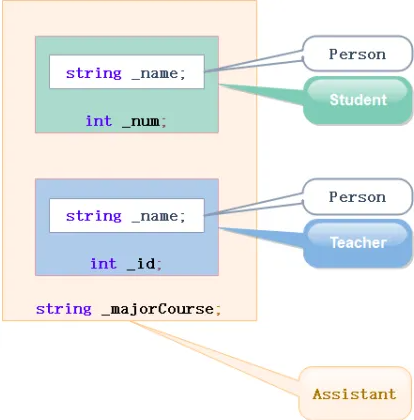
cpp
class Person
{
public:
string _name; // 姓名
int _age;
};
class Student : public Person
{
protected:
int _num; //学号
};
class Teacher : public Person
{
protected:
int _id; // 职工编号
};
class Assistant : public Student, public Teacher
{
protected:
string _majorCourse; // 主修课程
};
int main()
{
Assistant as;
as._age = 19; // 报错: 对"_age"的访问不明确
return 0;
}二义性可以被解决,但违背常理
cpp
int main()
{
Assistant as;
as.Student::_age = 18; // 指定访问
as.Teacher::_age = 30;
return 0;
}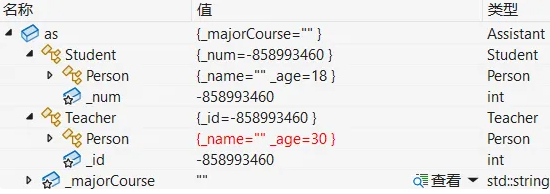
祖师爷引入了虚拟继承****,解决数据冗余、二义性
cpp
class Person
{
public:
string _name; // 姓名
int _age;
};
class Student : virtual public Person
{
protected:
int _num; //学号
};
class Teacher : virtual public Person
{
protected:
int _id; // 职工编号
};
class Assistant : public Student, public Teacher
{
protected:
string _majorCourse; // 主修课程
};
int main()
{
Assistant as;
as.Student::_age = 18;
as.Teacher::_age = 30;
as._age = 19;
return 0;
}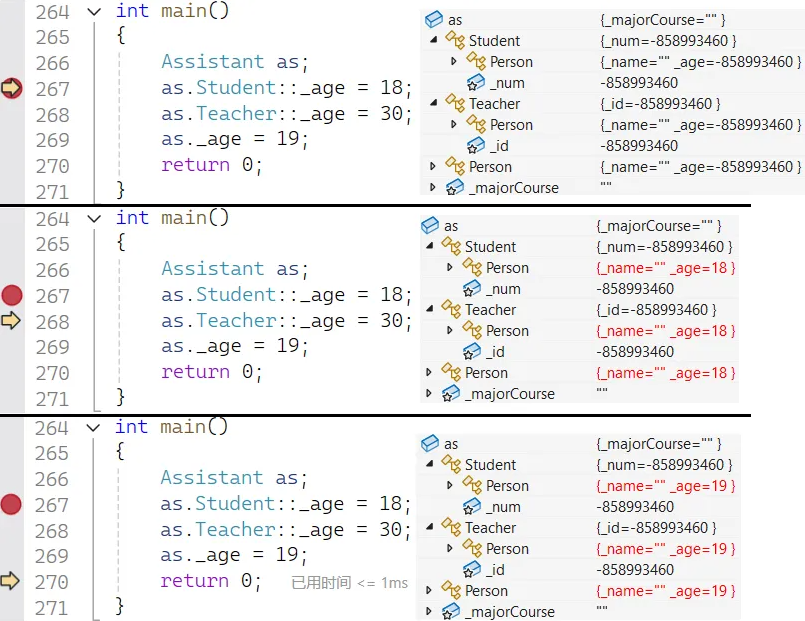
看着 as 里面有3份,实际是1份
虚拟继承解决数据冗余和二义性的原理
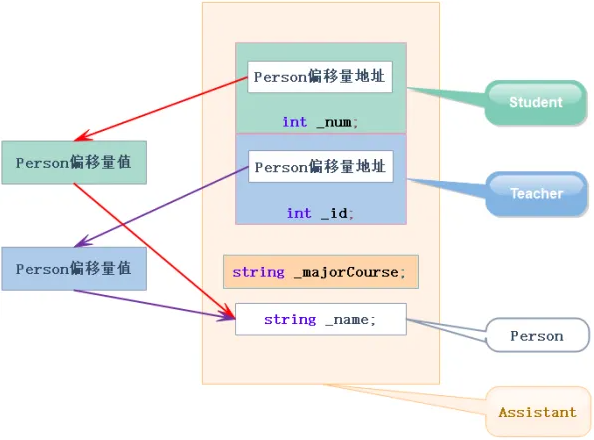
菱形继承:↓
cpp
class A
{
public:
int _a;
};
class B : public A
{
public:
int _b;
};
class C : public A
{
public:
int _c;
};
class D : public B, public C
{
public:
int _d;
};
int main()
{
D d;
d.B::_a = 1;
d.C::_a = 2;
d._b = 3;
d._c = 4;
d._d = 5;
return 0;
}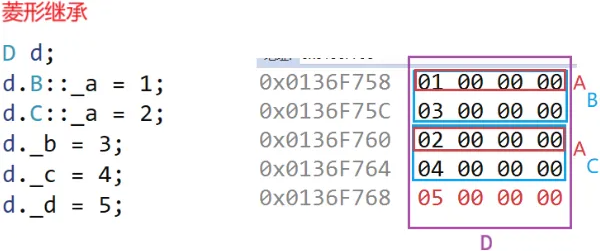
菱形虚拟继承:↓
cpp
class A
{
public:
int _a;
};
class B : virtual public A
{
public:
int _b;
};
class C : virtual public A
{
public:
int _c;
};
class D : public B, public C
{
public:
int _d;
};
int main()
{
D d;
d.B::_a = 1;
d.C::_a = 2;
d._b = 3;
d._c = 4;
d._d = 5;
d._a = 0;
D d1;
return 0;
}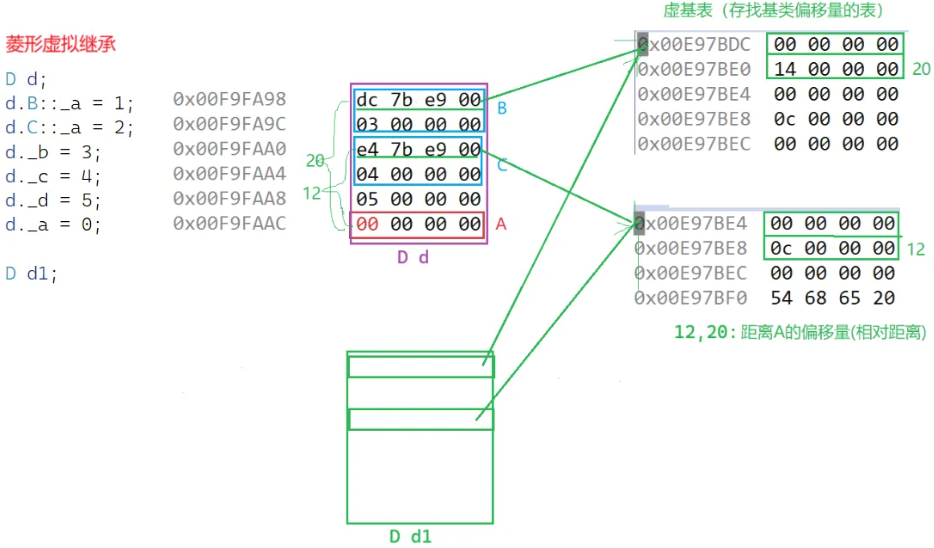
这样设计有什么用呢?
cpp
int main()
{
D d;
d._a = 0;
B b;
b._a = 2;
b._b = 3;
B* ptr = &b;
ptr->_a++;
ptr = &d;
ptr->_a++;
return 0;
}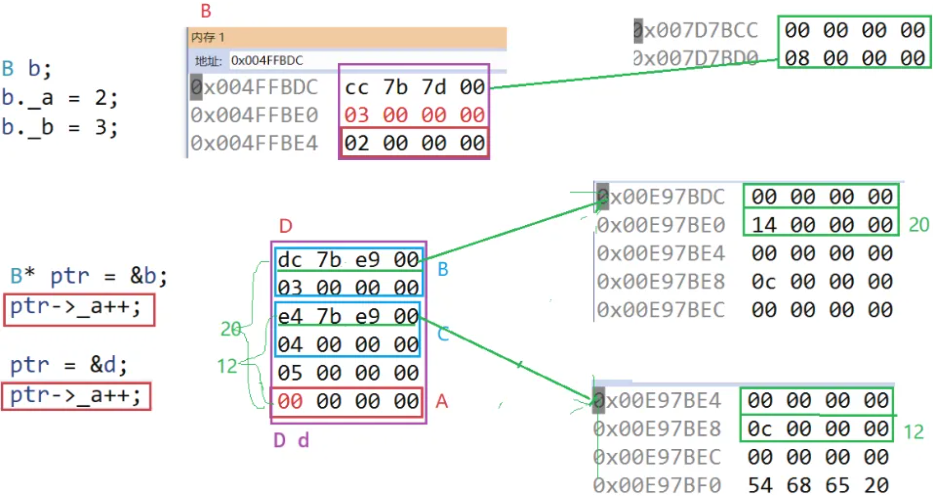
先取到偏移量,计算 _a 在对象中的地址,再访问
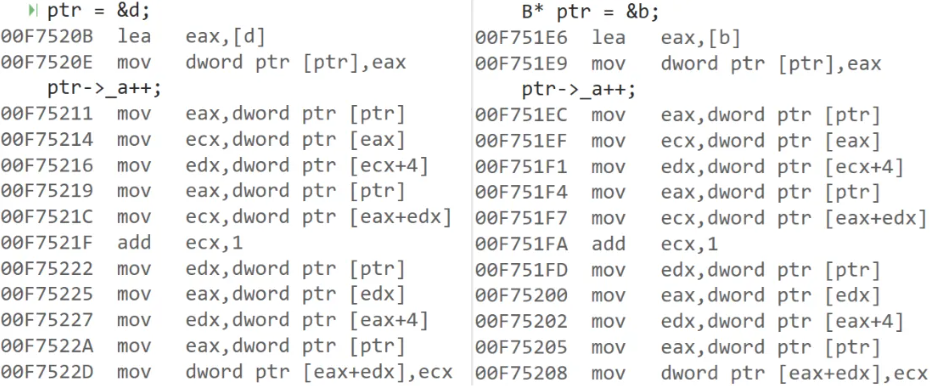
八. 继承和组合
cpp
class C
{
//....
};
// 继承
class D : public C
{};
// 组合
class E
{
private:
C _cc;
};继承一般不用 private
继承:白箱复用,父类的内部细节对子类可见;子类对象可以访问父类的 public、protected;父类和子类的耦合度高。改变父类的成员,子类要跟着改
组合**:黑箱复用,对象的内部细节不可见;E类只能用 C类的 public 和定义了友元的 protected;耦合度低**
实践中多用组合。继承和组合都可以,就用组合;更适合用继承的用继承;实现多态,必须用继承
public继承是 is-a 的关系:每个子类对象一定是父类对象
eg:教师、学生都是人
组合是 has-a 的关系:E 组合了 C,每个 E对象中都有一个 C对象
eg:E是车,C是轮胎,每个车都有轮胎
本篇的分享就到这里了,感谢观看 ,如果对你有帮助,别忘了点赞+收藏+关注 。
小编会以自己学习过程中遇到的问题为素材,持续为您推送文章